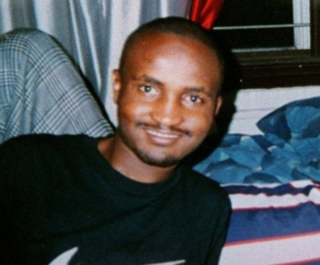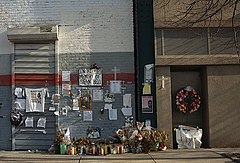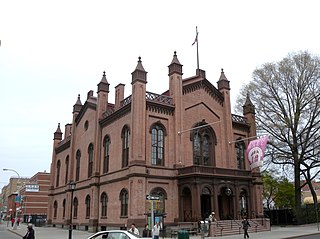
Alfred Charles Sharpton Jr. is an American civil rights activist, Baptist minister, television/radio talk show host and a former White House adviser for President Barack Obama. In 2004, he was a candidate for the Democratic nomination for the U.S. presidential election. He hosts his own radio talk show, Keepin' It Real, and he makes regular guest appearances cable news television. In 2011, he was named the host of MSNBC's PoliticsNation, a nightly talk show. In 2015, the program was shifted to Sunday mornings.

The shooting of Amadou Diallo occurred on February 4, 1999, when Amadou Diallo, a 23-year-old immigrant from Guinea, was shot and killed by four New York City Police Department plain-clothed officers—Sean Carroll, Richard Murphy, Edward McMellon and Kenneth Boss—after they mistook him for a rape suspect from one year earlier. The officers fired a combined total of 41 shots, 19 of which struck Diallo, outside his apartment at 1157 Wheeler Avenue in the Soundview section of The Bronx. The four were part of the now-defunct Street Crimes Unit. All four officers were charged with second-degree murder and acquitted at trial in Albany, New York.

Francesco Vincent Serpico is a former New York City Police Department (NYPD) officer who holds both American and Italian citizenship. He is known for whistleblowing on police corruption in the late 1960s and early 1970s, an act that prompted Mayor John V. Lindsay to appoint the landmark Knapp Commission to investigate the NYPD. Much of Serpico's fame came after the release of the 1973 film Serpico, which was based on the book by Peter Maas and which starred Al Pacino in the title role, for which Pacino received an Oscar nomination.

Abner Louima is a Haitian man who was assaulted, brutalized, and forcibly sodomized with a broken-off broom handle by officers of the New York City Police Department (NYPD) after he was arrested outside a Brooklyn nightclub in 1997.
Violent crime in New York City has been dropping since 1991 and, as of 2017, is among the lowest of major cities in the United States. In 2017, there were 290 homicides, the lowest number since the 1940s. According to a 2015 ranking of 50 cities by The Economist, New York was the 10th-overall-safest major city in the world, as well as the 28th-safest in personal safety.
Steven McDonald was a New York City Police Department (NYPD) patrolman who was shot and paralyzed on July 12, 1986. The shooting left him quadriplegic.
Ousmane Zongo was a Burkinabé arts trader living in New York City. He was killed in a homicide by a New York City Police Department officer, while unarmed, during a warehouse raid on May 22, 2003.

Anthony H. Gair is an American attorney and advocate. He is a partner of the law firm Gair, Gair, Conason, Rubinowitz, Bloom, Hershenhorn, Steigman & Mackauf, which was founded by his parents in 1945. He looks for cases that are in the public interest. Notably, he represented the family of Amadou Diallo in a case that spurred reform of the New York City Police Department. He lives in New York City. His only son Daniel Gair committed suicide on 3rd of February 2010.
The shooting of Timothy Stansbury Jr. occurred in New York City on January 24, 2004. Stansbury was an unarmed 19-year-old New York City man who was shot and killed by New York Police Department Officer Richard S. Neri Jr. on January 24, 2004. Officer Neri and a partner were patrolling the rooftop of a housing project in the Bedford-Stuyvesant neighborhood of Brooklyn at about 1 a.m. Officer Neri, with his gun drawn, approached a rooftop door to check the stairway inside. Neri testified to a Brooklyn grand jury that he fired his standard Glock 19 pistol unintentionally when he was startled as Stansbury pushed open the rooftop door. Stansbury, a resident of an adjoining building, died from one shot in the chest. The grand jury found the shooting to be accidental.
A contagious shooting is a sociological phenomenon observed in military and police personnel, in which one person firing on a target can induce others to begin shooting. Often the subsequent shooters will not know why they are firing, unless they are infantrymen, in which case they are expected to do so. For instance, if someone was a member of a fire team following the point man and he suddenly begins firing his weapon, there is a good chance that their element is in contact with the enemy. Prerequisites for a sworn peace officer regarding the discharge of a duty weapon are in no way comparable to those of a military unit engaged in a firefight.

Russel Timoshenko was a 23-year-old New York Police Department (NYPD) police officer who was shot on July 9, 2007, and died five days later, after pulling over a stolen BMW automobile in New York City's Crown Heights, Brooklyn, neighborhood. After a four-day manhunt that stretched across three states, all three suspects Dexter Bostic, Robert Ellis and Lee Woods were eventually apprehended and convicted—two of murder, and the third for weapons possession. At his widely attended funeral, Timoshenko was posthumously promoted to the rank of Detective. The case garnered national media attention because the weapons used were all illegally obtained handguns. This sparked widespread debate over gun control laws in New York City, and over the process by which firearms are traced by police departments.
Daniel Pagano is a New York mobster and a caporegime in the Genovese crime family who was involved in a famous gasoline bootlegging racket of the 1980s.
Allegations of misconduct and corruption have occurred in the history of the New York City Police Department (NYPD). Over 12,000 such cases have resulted in lawsuit settlements totalling over $400 million during a five-year period ending in 2014.

The 1972 Harlem mosque incident occurred on April 14, 1972, when a New York City Police Department (NYPD) officer was shot and fatally wounded at the Nation of Islam Mosque No. 7 in Harlem, Manhattan, New York City. The officer responded to a fake 9-1-1 call, but was shot and died from his wounds six days later. The incident sparked political and public outcry about mishandling of the incident by the NYPD and the administration of Mayor John V. Lindsay.

Mary Agnes Shanley was an American police officer and detective in the New York Police Department. She joined the department in 1931 and by 1939 was the fourth woman to achieve the rank of first-grade detective in the NYPD. She is credited with over a thousand arrests during her career. She was perhaps the first policewoman in New York City to use her gun in the arrest of a suspect.
On October 23, 2014, a hatchet-wielding man, Zale H. Thompson, attacked four New York City Police Department (NYPD) officers on a crowded sidewalk in the Jamaica neighborhood of Queens, New York City. Officer Kenneth Healey was struck in the head, while Officer Joseph Meeker was injured in the arm. Also injured was a female civilian, who was struck by a stray bullet when two other officers shot and killed the perpetrator. Investigators discovered that Thompson was a recent Muslim convert. His attack was classified as an act of terrorism.
Akai Gurley, a 28-year-old man, was fatally shot on November 20, 2014, in Brooklyn, New York City, United States, by a New York City Police Department officer. Two police officers, patrolling stairwells in the New York City Housing Authority (NYCHA)'s Louis H. Pink Houses in East New York, Brooklyn, entered a pitch-dark, unlit stairwell, one of them, Officer Peter Liang, 27, with his firearm drawn. Gurley and his girlfriend entered the seventh-floor stairwell, fourteen steps below them. The shooting was declared an accidental discharge; the bullet ricocheted off the wall and Gurley was fatally struck once in the chest.

On December 20, 2014, Ismaaiyl Abdullah Brinsley killed two on-duty New York City Police Department (NYPD) officers in the Bedford–Stuyvesant neighborhood of the New York City borough of Brooklyn, ostensibly as revenge for the death of Eric Garner and the shooting of Michael Brown, both of which were killings of unarmed black men by police. Brinsley then fled into the New York City Subway, where he committed suicide.
The shooting of Brian Moore, a New York City police officer, took place on May 2, 2015, in Queens, New York. Moore died two days later at Jamaica Hospital Medical Center, at the age of 25. His partner, Erik Jansen, was shot at but escaped injury. Demetrius Blackwell was arrested in connection with the shooting, and was formally charged with first-degree murder, attempted first-degree murder, and other charges. On December 19, 2017, Blackwell was sentenced to life in prison with no chance of parole.


















